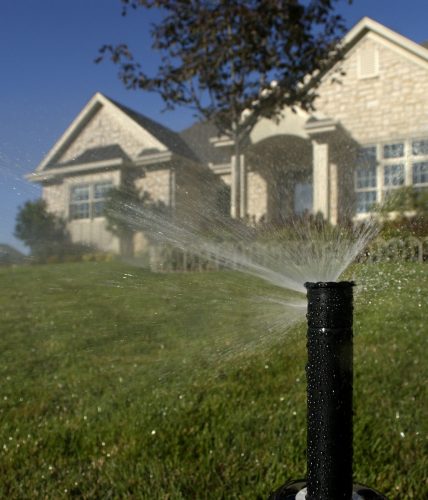Seven Springtime Sprinkler System Tune-Up Tips
Rising temperatures bring blooming flowers, beautiful landscapes and fun in the sun in your garden and on your lawn. It’s time now to make sure your automatic sprinkler system is ready for another season. April is National Lawn Care Month and Rain Bird, a leading supplier of irrigation products for residential, commercial, golf, and agricultural applications, suggests these seven simple steps to help homeowners save water, money and prevent a mid-summer landscape catastrophe.

1) Make sure spring has sprung.
Although all signs might be pointing to the arrival of spring, the soil beneath the landscape is always the last to thaw, especially in colder climates. Starting the sprinkler system while the ground is still frozen can result in damage to the pipes. Use a shovel to make sure that the soil is frost-free 12 inches deep. If it is still frozen, wait another week and test it again before starting the sprinkler system. (Before digging, make sure there aren’t any utility lines to hit!)
2) Take control.
Run a check of the irrigation controls and programs. This includes dusting away the cobwebs on the timer, making sure the date and time are correct, and that the settings are appropriate for your landscape’s watering needs and meet local watering regulations. Replace the back-up battery in the timer/controller annually and keep a copy of the watering schedule in a handy location.
3) Check for blockages.
Check for rocks, dirt, sand and other types of debris that may block the even flow of water from the sprinkler heads. Uneven distribution can lead to too much water in some areas and not enough in others resulting in an unhealthy landscape and wasted water. Inspect spray heads and make sure they haven’t become buried. Clear any debris that may have accumulated around them during the winter.
4) Inspect for broken or worn components.
Nozzles and sprinkler heads are designed to withstand normal wear and tear of irrigation, but are no match for errant lawn mowers, the neighbor’s dog or snowplows. Replace cracked, chipped or worn components, such as sprinkler heads, nozzles, valves or pipes. A broken sprinkler can wreak havoc on lawns, gardens, and water bills, so it is important to check and replace them periodically.
5) Examine the valves.
Valves are the heart of any irrigation system. They regulate the distribution of water throughout the entire system. A leaky valve will waste water and increase water bills. Visually inspect each valve to make sure they are operating properly. Before turning on any water to the system, make sure all manual drain valves are returned to the closed position. Be aware that overly wet areas in the lawn, resulting in muddy and/or barren patches, may be a result of a leaky valve.
6) Restore water pressure slowly and pressure check the system.
When restoring water to the sprinkler system, open the main water valve slowly to allow pipes to fill with water in a gradual and controlled manner, thus preventing pressure surge and costly damage. It’s a good idea to get a pressure gauge that attaches to a hose faucet to make sure the pressure is at a safe operating range for sprinkler systems – typically between 40 and 65 PSI. A system with too much pressure will result in cracked pipes, busted valves, sprinkler head leaks and inefficient watering. If your water pressure is too high, consider adding a pressure regulator.
7) Time for an upgrade?
Spring is also a good opportunity to consider upgrading your system to take advantage of improvements in sprinkler and controller technology. Pressure-regulated and water-efficient sprinkler options, like the Rain Bird 5000 Series rotors with Rain Curtain technology, can reduce overall irrigation water use. Consider upgrading your pop-up sprays to Rain Bird HE-VAN nozzles allowing you to shorten your sprinkler run times by up to 35 percent. Also, the latest generation of smart controllers, like the Rain Bird ST-8, provides more flexibility in scheduling, and can integrate with Alexa. These upgrades can save money on water usage and possibly qualify for a rebate from the government.
By following these seven simple steps, homeowners can have more than luck on their side to avoid some of the more common – and expensive – problems with automatic sprinkler systems.
Homeowners can find all these options and easy installation ideas online at rainbird.com or at their local Home Improvement Center. Or, consider using a local professional landscape architect or Certified Irrigation contractor to help keep the system in top condition. To locate a local landscaping or irrigation professional, visit Rain Bird’s free contractor referral section at: www.rainbird.com.






